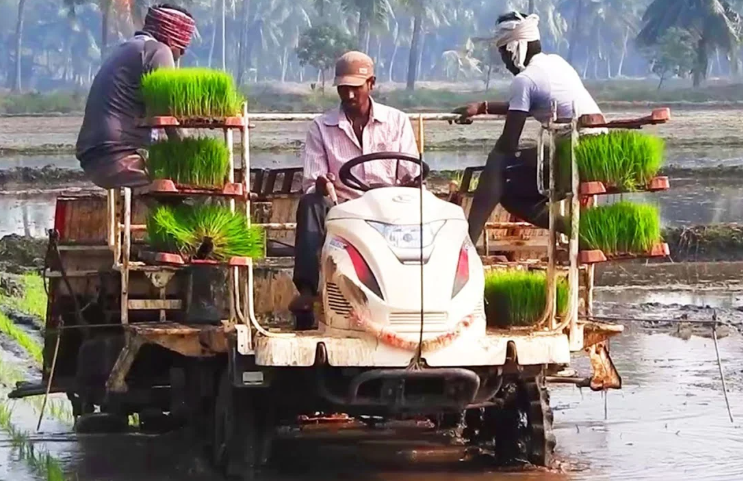Rice is a vital staple crop that feeds a significant portion of the world’s population. Rice farming has traditionally been labor-intensive and time-consuming, but with the advent of modern agricultural machinery, such as rice transplanter, farmers can now experience increased efficiency and productivity. In this guest post, we will explore the benefits of rice transplanters and their role in revolutionizing rice farming practices.
The Importance of Rice Farming
Rice is a staple food for billions of people worldwide, particularly in Asia. It is a major source of nutrition and plays a significant role in food security. Rice farming supports the livelihoods of millions of farmers and contributes to the socio-economic development of rural communities.
Tractors are versatile agricultural machines that have transformed modern farming practices, including rice cultivation. They are designed to perform various tasks, such as land preparation, plowing, leveling, seedbed preparation, and irrigation. Tractors significantly reduce the manual labor required in these processes, saving time, improving efficiency, and enabling farmers to achieve higher yields.
The Need for Efficient Rice Farming
Efficiency in rice farming is crucial to meet the growing demand for this staple crop. Traditional methods of rice cultivation, such as manual transplanting, are labor-intensive, time-consuming, and often lead to uneven plant spacing. These limitations hinder the overall productivity and profitability of rice farming.
Introducing Rice Transplanters
Rice transplanters are agricultural machines specifically designed to streamline the process of transplanting rice seedlings into paddy fields. These machines automate the planting process, reducing labor requirements and increasing efficiency. Rice transplanters come in various types, including walk-behind, riding, and self-propelled models, catering to the diverse needs of farmers.
Benefits of Rice Transplanters
Time and Labor Savings: Rice transplanters significantly reduce the time and labor required for transplanting rice seedlings. They can transplant seedlings at a much faster rate than manual labor, allowing farmers to cover larger areas in less time.
Uniform Plant Spacing: Rice transplanters ensure consistent plant spacing, resulting in better nutrient and water distribution and improved overall crop health.
Increased Yields: With precise planting and uniform spacing, rice transplanters help optimize plant growth, leading to higher yields and improved quality of rice grains.
Weed Control: Rice transplanters enable farmers to establish a dense and uniform crop canopy, suppressing weed growth and reducing competition for resources.
Water Conservation: Transplanted rice requires less water compared to direct-seeded rice, making rice transplanters a valuable tool for water conservation in regions facing water scarcity.
Adoption and Challenges
While the benefits of rice transplanters are significant, their adoption can be influenced by several factors. Initial investment costs, availability of machinery, training, and access to credit or financial assistance are some of the challenges that farmers may face. However, governments, agricultural institutions, and development organizations play a crucial role in promoting the adoption of rice transplanters by providing support, training, and access to financing options.
Understanding Tractor Loans
Tractor loans are specialized financial products offered to farmers to facilitate the purchase of tractors and other agricultural machinery. These loans are designed to support farmers in acquiring the necessary equipment to modernize their farming operations and enhance productivity. Tractor loans often come with flexible repayment options, competitive interest rates, and favorable terms tailored to the specific needs of farmers in the agricultural sector.
Rice farming is a crucial agricultural activity that supports the food security and economic stability of many countries. However, the manual labor involved in traditional rice farming methods can be laborious and time-consuming. To alleviate these challenges and enhance productivity, farmers can benefit from accessing tractor loans specifically tailored for rice farming. In this guest post, we will explore the importance of tractor loans in rice farming and the significant impact they have on empowering farmers to adopt mechanization for improved cultivation practices.
Benefits of Tractor Loans for Rice Farming
Enhanced Productivity: Tractors streamline farming operations, reducing the time and effort required for tasks like plowing, land preparation, and transportation of heavy loads. This increased efficiency translates into improved productivity and higher crop yields.
Cost Savings: By replacing manual labor with mechanized operations, tractors help farmers save on labor costs, which can be significant, especially during peak farming seasons.
Time Efficiency: With the power and speed of tractors, farmers can complete farming tasks in a fraction of the time compared to manual labor. This time efficiency allows farmers to optimize their resources and allocate time to other critical aspects of their farming operations.
Precision and Accuracy: Tractors are equipped with advanced technology, enabling precise operations such as controlled seed placement and accurate fertilizer application. This precision enhances crop growth, reduces waste, and ensures optimal resource utilization.
Sustainable Farming Practices: Tractors promote sustainable farming by optimizing inputs, reducing soil erosion, and improving overall land management. They enable farmers to adopt conservation agriculture practices that focus on preserving soil health and natural resources.
Accessing Tractor Loans for Rice Farming Government Initiatives: Many governments worldwide offer financial support programs and subsidies to encourage farmers to adopt mechanization. These initiatives often include tractor loan schemes with favorable terms and conditions.
Financial Institutions: Banks, cooperatives, and microfinance institutions provide tractor loan specifically tailored for agricultural purposes. These institutions understand the unique needs of farmers and offer flexible repayment options to suit their income cycles.
Agricultural Machinery Dealerships: Tractor dealerships often collaborate with financial institutions to offer financing options directly to farmers. These partnerships make it convenient for farmers to access tractor loans while purchasing machinery.
Empowering Rice Farmers through Tractor Loans
Tractor loans play a vital role in empowering rice farmers by providing them with the necessary resources to adopt mechanized farming practices. With access to modern machinery, farmers can improve their productivity, reduce labor dependency, and increase their income potential. Tractor loans promote sustainable and efficient rice farming, driving economic growth in rural communities.
Conclusion
Rice transplanters have emerged as game-changers in the realm of rice farming. By automating the transplanting process, these machines enhance efficiency, reduce labor requirements, and improve crop yields. Encouraging the adoption of rice transplanters through training, financial support, and knowledge sharing will pave the way for sustainable and productive rice farming practices globally. Tractor loans have revolutionized rice farming by enabling farmers to embrace mechanization and optimize their operations. Access to affordable financing for tractors empowers farmers to enhance productivity, save costs.












